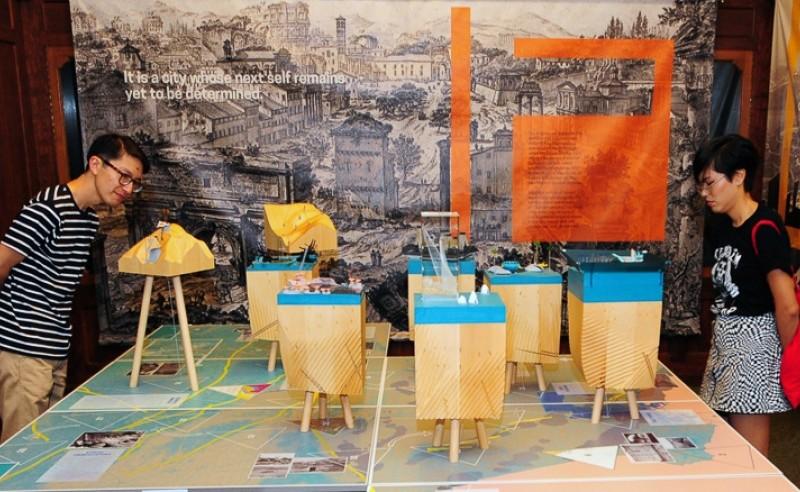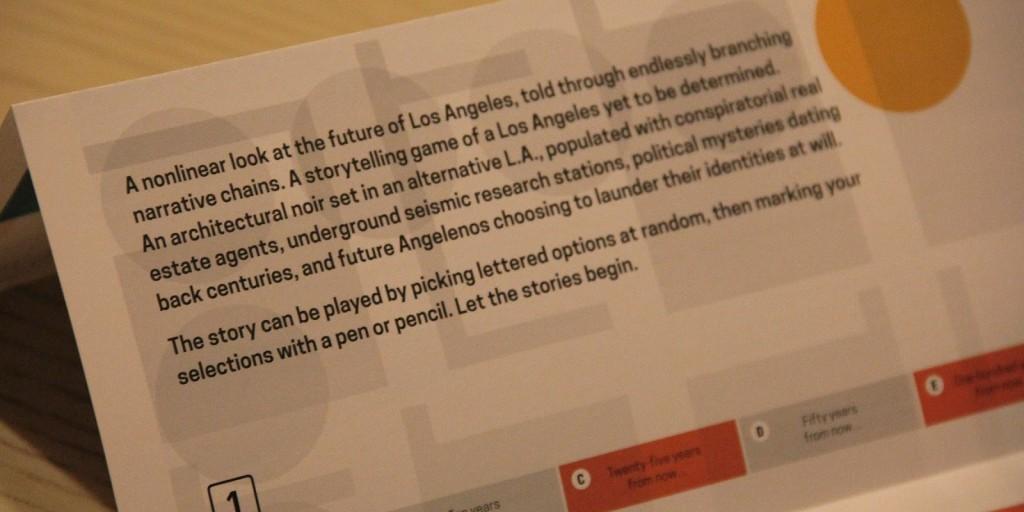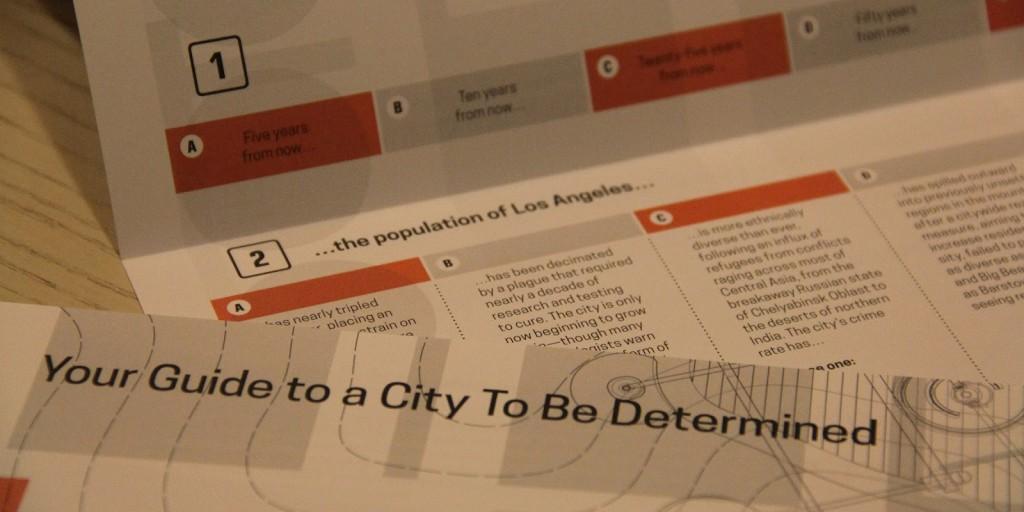 A new art installation opened last month at the University of Southern California’s Doheny Memorial Library that takes a fictional stroll through the future of one of the United States’ most iconic and expansive cities. Called L.A. T.B.D., the project was created by design writer and 2015’s USC Library Discovery Fellow Geoff Manaugh in collaboration with Smout Allen, a London-based husband-and-wife architect team–Mark Smout and Laura Allen–to tell the possible future histories of Los Angeles that have yet to be written. Manaugh was challenged to dig into the expansive historical archive of USC and try to piece together the city as it was, as it is now and what future is yet To Be Determined.
A new art installation opened last month at the University of Southern California’s Doheny Memorial Library that takes a fictional stroll through the future of one of the United States’ most iconic and expansive cities. Called L.A. T.B.D., the project was created by design writer and 2015’s USC Library Discovery Fellow Geoff Manaugh in collaboration with Smout Allen, a London-based husband-and-wife architect team–Mark Smout and Laura Allen–to tell the possible future histories of Los Angeles that have yet to be written. Manaugh was challenged to dig into the expansive historical archive of USC and try to piece together the city as it was, as it is now and what future is yet To Be Determined.
Los Angeles’ possible futures are depicted in several unique ways, including eight detailed architectural models presenting differing possibilities, a diverse narrative of the city’s past and future told through speculative fiction, carefully selected historical artifacts from the USC archives and even by incorporating game design. Manaugh believes that the history of LA that is yet to come may be revealed by examining the key forces that shaped Los Angeles into the city that it is today. That includes its history of global astronomy, the varied coastal ecologies, its mix of alternative religions and the rise, and possible fall, of its notorious system of freeways. L.A. T.B.D. will not only help visitors peer into the city’s far-flung future, but will also allow them to create their own unique visions of what is yet to come for Los Angeles.
“Like plotting a ballistic trajectory, if we know where L.A. has been—if we can see the ingredients of its past, from its prehuman landscapes to the 2012 procession of the Space Shuttle—can we determine where the city might be, 10, 20, 100 years from now? The overall curatorial idea was that, hidden within USC’s impressive and seemingly endless archival holdings, there might be glimpses of an L.A. yet to come, and that a project such as this should find a way of bringing that future version of the city into focus,” Manaugh explained on his blog.
Guests are guided through the exhibit by using a David Mellen designed pamphlet that presents it as if they were playing an expansive adventure board game. Along the way historical artifacts from the USC Library’s holdings are incorporated into this possible false narrative, including old scientific reports, transportation policy papers, obsolete 1980s urban predictions and even old board games that feature LA as a backdrop.
But don’t trust everything that you see; like Los Angeles itself, the history that they’re telling may not be what it seems. While the architectural models are the star of the show, it’s the interactive text written by Manaugh and Mellen that act as both connective tissue between them, and as a way for visitors to walk through the installation telling their own stories.
“This text combines a small-scale look at what sort of Los Angeles might yet greet our unborn descendants—complete with neighborhoods flooded by sea-level rise, widespread demographic shifts, and corrupt political machinations—with a subtext of noir or urban mystery. I started referring to this as a kind of architectural or infrastructural noir, and I’ve come to really like the phrase: the accompanying exhibition text is thus not at all what you’d expect to see in a typical gallery setting, but instead tells an endlessly branching ‘noir’ about the next Los Angeles—by, in some ways, revealing what Los Angeles really was, all along,” Manaugh continued.
One of the more interesting architectural models presents a seismographic planetaria that splits open the Earth so visitors can look deep into the ground and up at the stars at the same time. The hypothetical attraction is built on the old Chavez Ravine, which was the home of a historic 1940s Mexican-American neighborhood. While inhabited by the working poor, it was unfortunately on top of what many white city officials viewed as prime real estate. After forcing the Hispanic population out, the city officials’ plans for public housing – for white people – was derailed by the country’s growing “red-scare.” The proposed “Elysian Park Heights” was considered too socialist of an idea, so the land eventually was sold and then developed into Dodgers Stadium. This would be an ironic end for the controversial plot of land, as if ripping away the land itself would hide the past sins committed there.
Other models feature giant pendulums suspended below the city that were designed to counter any seismic activity, while another model uses that same seismic activity as a new way for LA to harness power by converting earthquakes into renewable energy. Another possible future sees the city’s mountain top ring of observatories turned into the center of modern astronomy. And a different model depicts the city’s freeway system used as an astronomical device by placing markers that connect it with the stars above, essentially shaping the city around the universe.
- SmoutAllen LA TBC modelBartlett School of Architecture, UCL, 140,Hampstead Road, London.
The Smout Allen designed models were made with several different materials and fabrication technologies, including 3D printing, milled polyurethane, sprayed and mirrored acrylic, and a massive block of laser-etched crystal resin. The bases of each model, and even some of the hills themselves, were carved from solid blocks of lime wood that represent the cities geological strata including the areas fault lines carved into them.
The exhibition will be on display in the Doheny Memorial Library’s Treasure Room at the University of Southern California from Oct 15 2015 through January 31, 2016. If you are local and want to stop by, you can find the the library’s operating hours here. Discuss this story in the Modelling Los Angeles Forum thread on 3DPB.com.
[Model Photos: Stonehouse Photographic]
Subscribe to Our Email Newsletter
Stay up-to-date on all the latest news from the 3D printing industry and receive information and offers from third party vendors.
Print Services
Upload your 3D Models and get them printed quickly and efficiently.
You May Also Like
Nikon SLM Solutions Sells SLM 500 to Primary Weapon Systems to Expand Suppressor Production
Primary Weapons Systems (PWS) is a Boise, Idaho-based manufacturer of suppressors, firearms, and related components. A subsidiary of Vigilant Gear and a sister company to aftermarket Glock slide manufacturer Lone...
3DPOD 261: Tooling and Cooling for AM with Jason Murphy, NXC MFG
Jason Murphy´s NXC MFG (Next Chapter Manufacturing) is not a generalist service; instead, the company specializes in making tooling. Using LPBF and binder jet, the company produces some of the...
HP and Firestorm Labs Form Partnership to Use Multi Jet Fusion 3D Printers in Deployable Factories
HP Inc., maker of a range of additive manufacturing (AM) solutions including the Multi Jet Fusion (MJF) ecosystem, has announced a partnership with Firestorm Labs, a developer of containerized, deployable...
3D Printing News Briefs, July 2, 2025: Copper Alloys, Defense Manufacturing, & More
We’re starting off with metals in today’s 3D Printing News Briefs, as Farsoon has unveiled a large-scale AM solution for copper alloys, and Meltio used its wire-laser metal solution to...




































